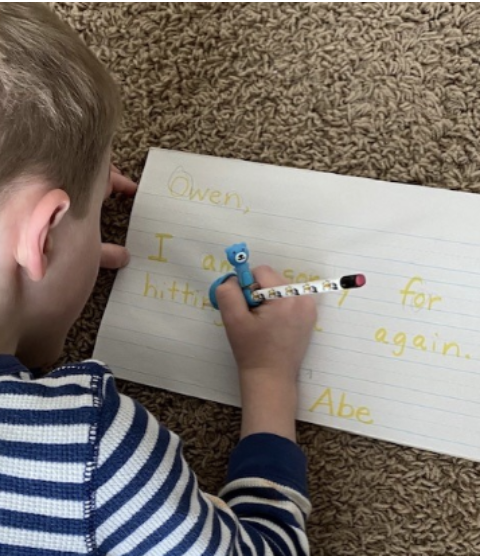Stop, Think, and Write: A Behavior & Mind Management Strategy
CategoriesMy 5-year-old son, Abe (who is typically a kind boy), recently started hitting his 3-year-old brother. The physical aggression seemed to stem from impulsivity, frustration, or a combination of both. When my response of a time-out, followed by a verbal apology wasn’t working, I knew I had to figure out a different approach.
I continued with the time-out (quiet time to think in his bedroom for about 4-5 minutes), but instead of having him verbally apologize, I guided my son with writing an apology letter. We talked about what happened and what he will do differently next time. Because he is only 5 years old - and his writing skills are still developing, I kept the letter very simple and dictated his words with a highlighter for him to trace over.
I was a bit disheartened (but honestly, not surprised) when he had to write a second letter that same day - again for hitting his brother. But that evening as I was getting ready to read bedtime stories with both boys, I noticed Abe winding up to hit his brother when they couldn’t agree on which book to read first, but he stopped himself short before making contact - progress! I realize this is a study of one, but after writing those initial two letters, Abe has gone 8 days and counting without hitting his brother.

Owen,
I am sorry for hitting you again.
-Abe
Although writing an apology letter is not a new strategy, it’s definitely one worth revisiting. When I taught at the elementary level, we implemented a procedure called “Stop & Think” for students involved with physical and verbal aggression and other serious disruptive, defiant, and disrespectful behaviors.
In summary, the Stop & Think procedure consists of:
-
Removing student(s) from the situation – escorting them to the school psychologist’s office or other available space
-
Setting a timer for a predetermined amount of time (5-10 minutes), allowing student to calm down with suggested relaxation strategies (take deep breaths, think calm thoughts, count slowly)
-
Having the student complete a problem-solving form (with guidance as necessary). For example:
- Identify feelings.
- (I felt ________ when ________.
- My behavior probably made others feel ________.)
- State the problem without blame.
- Think of 2-3 solutions.
- Explore consequences of each solution.
- Pick the best solution.
- Make a plan. (Next time, I will ________.)
-
An adult discussing the completed problem-solving form with the student
-
Working with the student on taking responsibility for their behavior by developing a plan that includes restorative activities such as writing and delivering an apology letter and repairing any damage
Neuroscientist and author, Dr. Caroline Leaf was a recent guest on the mindbodygreen podcast with Jason Wachob (one of my favorite podcasts). During the interview, she shared five steps to change your brain in order to manage thoughts, feelings, and behaviors in more positive and healthy ways. I was pleasantly surprised to notice several parallels between Dr. Leaf’s steps and the Stop & Think process.
-
Gather – Become aware of what you are thinking, and how you are feeling and behaving.
-
Reflect – What are you trying to learn from this experience?
-
Write – Write down (not type) your thoughts to release them from your mind.
-
Reconceptualize – Reframe your thoughts into a “possibilities mindset”.
-
Active Reach – Identify an action you can take – no matter how seemingly small (for example: take deep breaths, repeat a mantra).
As Dr. Leaf stated, “When you write, you activate certain parts of the brain in a beautiful way.” I could not agree more. From getting your kid to stop hitting his younger brother to keeping life events in perspective, there are numerous proven benefits associated with stopping, thinking, and writing - for people of all ages.
Here are a few classes related to this topic:
 Social and Emotional Learning: Promoting Positive Mental Health Across the Curriculum
Social and Emotional Learning: Promoting Positive Mental Health Across the Curriculum
 Trauma, Stress, and Anxiety in Schools: Finding Hope and Building Resilience
Trauma, Stress, and Anxiety in Schools: Finding Hope and Building Resilience
 Refocusing Attention: Tackling Student Distractions by Gaining Their Attention
Refocusing Attention: Tackling Student Distractions by Gaining Their Attention